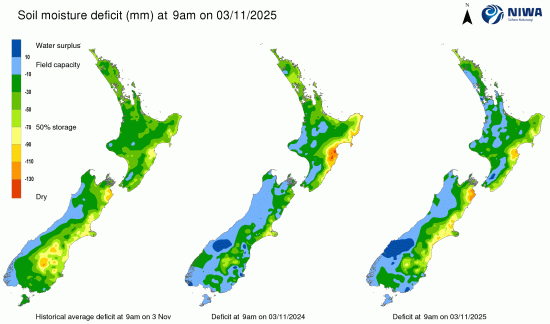Here's our summary of key economic events over the weekend that affect New Zealand, with news risk aversion is the theme of the day for investors who seem particularly jittery about AI valuations, crypto prices, and the prospects for the US economy.
But first, we start today with the results of another full dairy auction, and they aren't good. Not so much because the overall result was down -3.0% in USD terms, more because that makes it seven declines in a row from early August, taking the cumulative drop to -13%. And the recent retreats seem to be getting more intense. We now have prices lower than year-ago levels. And the decline in USD is being matched by the decline in NZD now, down -2.9% in this latest event.
Clearly analysts will be dusting off their current season payout forecasts because they are risk of being downgraded. Behind the softness is a faster-than-expected rise in dairy production levels due to good weather conditions globally. That is as true for New Zealand as anywhere, where milk production is rising. The pointy end of this pressure is the butter price, and that dropped -7.6% at this latest auction. WMP was down a lesser -1.9%, SMP down only -0.6%.
In the US, the ADP weekly payrolls report delivered another drop, the one for the week to November 1 not as sharp as the prior week however. This data suggests the US labour market lost momentum in late October, with a number of large companies announcing job cuts during the month, including Amazon and Target.
Official data releases are being restarted in the US, but the data is old now. Overnight they said August factory orders rose to be +2.0% higher than year-ago levels. But because this is not inflation-adjusted and the past US PPI rise was +2.6%, it probably means shrinkage in real terms. There has been no indication this things have improved from August.
And restarted official jobless claims data is only for October 18, but it rose then to +232,000 and above the expected level of +223,000. Continuing claims were a touch under 2 mln (1.96 mln) and notably above the 1.85 mln in the same week in 2024.
The US NAHB housing market index came in essentially unchanged for October from September and -17% lower than year-ago levels. But they will be pleased it didn't drop back.
Yesterday we reported a good improvement for factories in the New York region. But today the report for the very much bigger services sector in the same region has remained very negative.
We could perhaps note that the Atlanta Fed monitors home loan affordability for the US is a similar way we do for New Zealand. They say that in September 2025, 43% of take-home pay was required to service an American mortgage and that is 'unaffordable'. They say affordability starts when it is 30% or less. (Our New Zealand September HLA was 33.0%.)
In Canada, housing starts dropped sharply in October to their lowest in six month and to levels lower than the same month a year ago.
The Australian central bank released the minutes of its last meeting on November 4 yesterday, closely-watched because they have rising inflation and a relatively strong labour market. But they downplayed both aspects, calling them 'slight' and expecting them to be transitory. Policy was still viewed as slightly restrictive, and the board saw “no need to adjust” the cash rate. They said patience was deemed appropriate while assessing spare capacity, labour trends, and policy stance. Scenarios supporting a hold included stronger demand, lower supply capacity, or a view that policy was no longer restrictive. Conversely, further easing could be warranted if labour conditions weaken or growth disappoints. Basically, you don't learn anything by reading these minutes.
The UST 10yr yield is now at 4.14%, up +1 bp from this time yesterday. The key 2-10 yield curve is now at +54 bps. Their 1-5 curve is +3 bps positive and the 3 mth-10yr curve is +18 bps positive. The China 10 year bond rate is unchanged at 1.81%. The Australian 10 year bond yield starts today at 4.44%, down -2 bps. The NZ Government 10 year bond rate starts today at 4.31%, down -3 bps.
Wall Street has started today with the S&P500 down -0.3%, and awaiting that Nvidia earnings report. Overnight, European markets were all lower between London's -1.3% and Paris's -1.9%. Yesterday, Tokyo closed is Tuesday session down a sharp -3.2%. Hong Kong was down -1.7% and Shanghai was down -0.8%. Singapore dropped -0.8%. The ASX200 was down -1.9% in its Tuesday trade. And the NZX50 fell -1.2%.
The price of gold will start today at US$4061/oz, and down -US$6 from this time yesterday.
American oil prices have softened very slightly from yesterday to be just under US$60/bbl, with the international Brent price down -50 USc to US$64/bbl.
The Kiwi dollar is now at just on 56.6 USc, and down -10 bps from yesterday. Against the Aussie we are down -10 bps at 87 AUc. Against the euro we are also little-changed at 48.9 euro cents. That all means our TWI-5 starts today at just over 61.2, and down -10 bps from yesterday.
The bitcoin price starts today at US$93,460 and down -0.4% from yesterday and it is still lower than year-ago levels. At one point in the past 24 hours it dipped below US$90,000. Volatility over the past 24 hours has been moderate at just on +/- 2.6%.
Daily exchange rates
Select chart tabs
The easiest place to stay up with event risk is by following our Economic Calendar here ».
13 Comments
I’ve never understood Nvidias share price. Sure they may cream it while they are the monopoly GPU provider for AI, but how long can that last before another company build something that competes? Even if the other product wasn’t as good but was half the price. I bet many companies are trying. And also once the big cloud companies have loaded up on hardware, won’t the demand drop too?
Nvidia's chips have long been the top layer for game players, so the AI extension is logical. There are competitors such as AMD, but perhaps they were not as quick to develop AI focussed chips?
The competitors now have 4.5 trillion reasons to try harder, not like when it was a market for a few gamers.
Also a gamer will pay top dollar to get the best rig, an AI company will be looking for bang for buck. The competition don’t need a great chip, they just need a more affordable one.
I think they are in a similar territory to Tesla. There is no reason to believe they will dominate the market forever.
In the early 2000's Nvidia and AMD were essentially on a par. Some preferred one over the other and vice versa. I seem to recall AMD being considered as a 'disrupter' at the time, but an effective competitor to Nvidia.
Most hardware ultimately gets commodified to the point of eroding most of the margin.
Maybe this time it's different.
Look up “circular AI funding”…. It’s got ponzi written all over it
It can’t last forever can it. If everyone is buying overpriced stuff off each other, another company will see a big opportunity to undercut them all. And it’s a very big opportunity.
Moore’s Law. Technology is still growing at an exponential rate so the leader in development actually pulls away from its competitors rather than them catching up. Hence the whole China/Taiwan issue is that the chips in Taiwan will always be faster better stronger until we reach a point at which Moore’s Law breaks I guess.
It is interesting to note the US identify that the threshold for mortgage "affordability" as 30% of take home pay. I have long argued that the total cost of renting, should be between 25 - 30% of take home pay.
I acknowledge that home ownership costs are not always as visible as renting, but they are there none the less. neglect can lead to them escalating dramatically. In addition home owners can sink considerable funds into their property making into something they want to live in, as well as sustaining and adding to it's ultimate value for resale.
It’s an arbitrary number really. It’s the trend of percentage of income needed for housing that matters more.
I'm not sure I agree with it being 'arbitrary'. If housing costs take too much, then the ability to provide the other essentials of life become threatened. Creep is too easy to dismiss when it occurs slowly, but that doesn't make it acceptable. Plus this site is about the economy and that relies on people having surplus funds to spend. If housing costs are too high, then that impacts on other aspects of the economy being adversely impacted.
We don't tend to set an arbitrary income percentage to "affordable food", "affordable transport", etc.
The problem is that people's demand increases with income. If my income were to double, I probably would spend about the same percentage on housing (or maybe more), I'd just have a better house (or perhaps a bach as well). The richer you are, the more income you have left over after the core fixed expenses, the more you have to spend on what were once considered luxuries like ensuites, second living rooms, studies, central heating, double glazing, etc. The same thing happens with food, travel, etc.
The share market dips will be pounding our KiwiSaver gains.


We welcome your comments below. If you are not already registered, please register to comment.
Remember we welcome robust, respectful and insightful debate. We don't welcome abusive or defamatory comments and will de-register those repeatedly making such comments. Our current comment policy is here.